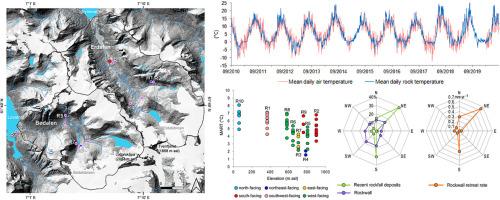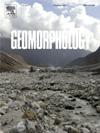将十年的岩石温度监测与挪威西部陡峭山谷的岩壁风化过程联系起来
IF 3.1
2区 地球科学
Q2 GEOGRAPHY, PHYSICAL
引用次数: 0
摘要
关于岩壁霜冻机制和岩壁霜冻风化的现有研究大多集中在受永久冻土影响的岩壁上。然而,在挪威和其他许多寒冷气候环境中,有很大一部分岩壁表面实际上是没有永久冻土的。因此,这些无永久冻土的岩壁系统将如何应对未来空气和岩石温度的变化是一个令人感兴趣的问题。在本研究中,我们报告了在当前永久冻土极限下的岩壁进行的实地测量,并研究了岩壁的热机制,包括有永久冻土和无永久冻土的岩壁区域。我们展示了一个独特的岩壁温度测量数据集,该数据集由安装在挪威西部两个山谷中的十个温度传感器提供,时间长达十年。我们分析了受永久冻土影响的岩壁和无永久冻土的岩壁在岩石风化和相关落石供应方面的不同岩壁热机制。在我们的研究区域,东北面岩壁的近期岩壁风化强度最高,包括确定的岩壁退缩率和相关的落石供应量,其次是南面岩壁。冻裂活动(可能以离析冰生长的形式出现)似乎是东北向岩壁风化强度较高的一个重要因素,而太阳辐射引起的热应力有利于增量亚临界裂缝的生长,被认为是南向和西南向岩壁风化强度适中的一个相关因素。据估计,在我们的十年调查期(2010-2020 年)内,整个研究区域的岩壁年平均退缩率为 0.24 mm/yr-1,与其他已公布的类似岩性和气候条件下的退缩率相当。可以认为,季节性霜冻机制和永久冻土将对当前和未来的气候变化做出不同的反应,因此应更加重视分析这两种不同的热机制对岩壁机械风化和相关落石供应可能产生的不同影响。本文章由计算机程序翻译,如有差异,请以英文原文为准。

Relating ten years of rock temperature monitoring to rockwall weathering processes in steep mountain valleys in western Norway
Most existing studies on rockwall frost regimes and frost weathering at rockwalls focus on permafrost-affected rockwalls. However, a high share of rockwall surface areas in Norway and in many other cold-climate environments is actually free of permafrost. It is therefore of interest how these permafrost-free rockwall systems will respond to future changes in air and rock temperatures. In this study, we report field measurements conducted at rockwalls beneath the current permafrost limit and investigate thermal regimes at rockwalls that include both rockwall areas with and without permafrost. We present a unique dataset of up to ten years of rockwall temperature measurements from ten temperatures sensors installed in two mountain valleys in western Norway. An analysis of the different rockwall thermal regimes with respect to rock weathering and associated rockfall supply for both, permafrost-affected and permafrost-free rockwalls is provided. The highest intensity of recent rockwall weathering including determined rockwall retreat rates and associated rockfall supply is detected for northeast-facing rockwalls followed by south-facing rockwalls in our study area. Frost cracking activity, probably in the form of segregation ice growth, seems to be an important factor particularly for the high weathering intensity on northeast-facing rockwalls whereas solar radiation-induced thermal stresses, which favour incremental subcritical crack growth, is assumed to play a relevant role in the moderate weathering intensity on south- and southwest-facing rockwalls. A mean annual and study area-wide rockwall retreat rate of 0.24 mm yr−1 is estimated for our ten-year investigation period (2010−2020) which is comparable to other published rates in similar lithologies and climates. As it can be assumed that seasonal frost regimes and permafrost will react differently to ongoing and future climate changes, more attention should be paid to analyse these two different thermal regimes with respect to possible varied implications for mechanical rockwall weathering and associated rockfall supply.
求助全文
通过发布文献求助,成功后即可免费获取论文全文。
去求助
来源期刊

Geomorphology
地学-地球科学综合
CiteScore
8.00
自引率
10.30%
发文量
309
审稿时长
3.4 months
期刊介绍:
Our journal''s scope includes geomorphic themes of: tectonics and regional structure; glacial processes and landforms; fluvial sequences, Quaternary environmental change and dating; fluvial processes and landforms; mass movement, slopes and periglacial processes; hillslopes and soil erosion; weathering, karst and soils; aeolian processes and landforms, coastal dunes and arid environments; coastal and marine processes, estuaries and lakes; modelling, theoretical and quantitative geomorphology; DEM, GIS and remote sensing methods and applications; hazards, applied and planetary geomorphology; and volcanics.
 求助内容:
求助内容: 应助结果提醒方式:
应助结果提醒方式:


